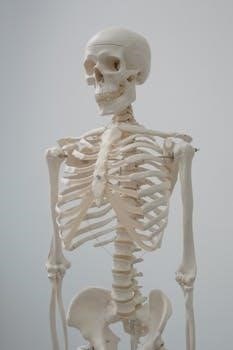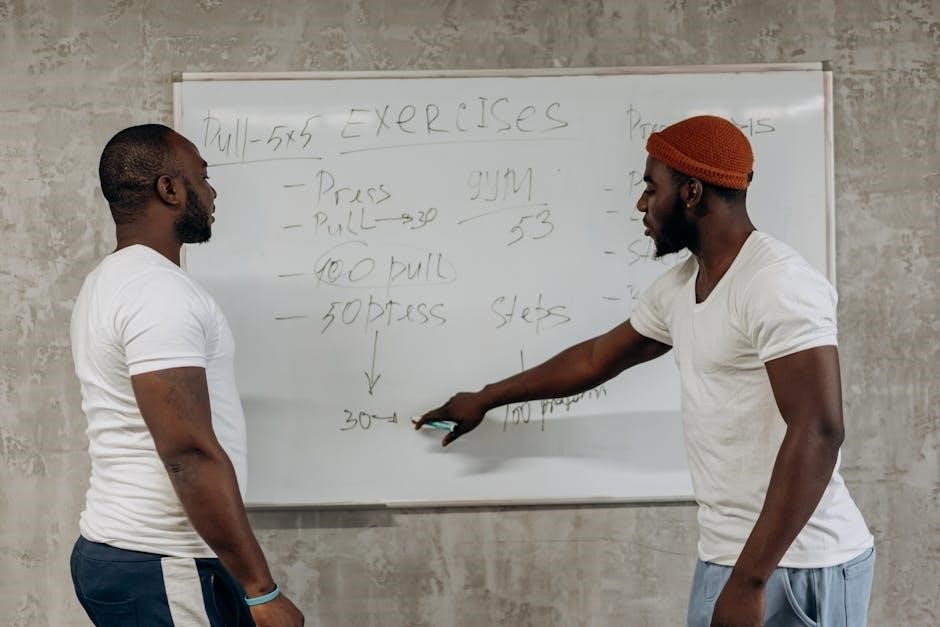Rehabilitation Protocols for Humerus Fractures
This section outlines various rehabilitation protocols for humerus fractures, encompassing both operative and non-operative approaches. The protocols emphasize a phased progression from early protection to functional exercises, ensuring optimal healing. These protocols incorporate specific exercises and techniques to restore range of motion, strength, and function.

Proximal Humerus Fracture Rehabilitation Phases
Rehabilitation for proximal humerus fractures typically progresses through distinct phases, each with specific goals. The initial phase focuses on healing and pain management, often involving immobilization and gentle range of motion exercises. This early stage is crucial for protecting the fracture site and allowing for initial bone healing. The next phase transitions towards functional rehabilitation, where the focus shifts to regaining strength, mobility, and coordination. Specific exercises, often active-assisted, are introduced to progressively challenge the shoulder. As the patient progresses, resistance exercises are added to further improve strength and stability. Finally, the maintenance phase aims to ensure long-term functional recovery and prevent re-injury. This involves continued strengthening, activity modification, and patient education on proper body mechanics. Each phase builds upon the previous, adapting to the individual’s progress and needs. These phased approaches are essential for a successful rehabilitation outcome.
Healing Phase of Proximal Humerus Fractures
The healing phase of proximal humerus fracture rehabilitation is characterized by early protection and controlled movement. During this period, the primary goals are to minimize pain, reduce swelling, and promote bone healing. Immobilization is often necessary, typically with a sling or brace, for 2-3 weeks, to allow the fracture site to stabilize. Gentle, pain-free range of motion exercises, such as pendular swings, are initiated early to maintain joint mobility and prevent stiffness. These movements are often passive or active-assisted, ensuring the shoulder isn’t overloaded. It is crucial to avoid any movements that may cause excessive pain or stress on the fracture. Emphasis is placed on allowing the body’s natural healing processes to occur while preventing complications. Patients are educated on proper posture, movement precautions, and pain management techniques. The healing phase lays the foundation for subsequent stages of rehabilitation.
Functional Rehabilitation for Humerus Fractures
The functional rehabilitation phase for humerus fractures focuses on restoring the ability to perform daily activities and tasks. Once adequate healing has occurred, the emphasis shifts from protection to active movement and strengthening. Exercises become more challenging, progressing from active-assisted range of motion to active range of motion and light resistance exercises. The goal is to improve shoulder strength, stability, and coordination. Specific exercises may include shoulder flexion, abduction, and rotation exercises, gradually increasing the range and intensity. Functional exercises that mimic real-life activities are incorporated to improve overall performance. This phase also focuses on restoring scapular control and stability, crucial for optimal shoulder function. Progression is guided by pain levels and the patient’s ability to perform exercises correctly. The aim is to return to pre-injury functional capacity.
Maintenance Phase for Humerus Fractures
The maintenance phase of rehabilitation for humerus fractures is designed to sustain the gains achieved during the functional rehabilitation phase and to prevent re-injury. This phase involves a long-term exercise program focusing on maintaining strength, range of motion, and functional abilities. Regular exercises, including strengthening and flexibility, are performed to ensure continued improvement and stability. The emphasis is on self-management, encouraging patients to continue their exercise program independently. Activities are progressed to include more complex movements and tasks, tailored to individual needs and goals. This phase incorporates exercises that are performed at a higher intensity, ensuring that the patient is able to perform daily tasks without pain or discomfort. The program will consist of exercises aimed to prevent muscle imbalances and maintain shoulder health; Patients are encouraged to incorporate these exercises into their routines to avoid any regression and maintain a healthy shoulder function.
Non-Operative Proximal Humerus Fracture Rehabilitation
Rehabilitation for non-operative proximal humerus fractures focuses on a conservative approach, emphasizing early protection and gradual progression. The initial phase involves immobilization for a period of two to three weeks, allowing for initial healing and pain reduction. Following this, gentle range of motion exercises are initiated to prevent stiffness and improve mobility. Pendular swings and active-assisted movements are introduced to gradually increase shoulder mobility without overstressing the healing fracture. Resistance exercises are typically introduced around six weeks post-injury, ensuring the fracture has sufficient time to heal. Throughout the process, pain is monitored to prevent exacerbation of the injury. The protocol emphasizes the importance of avoiding excessive stress on the shoulder and slowly progresses the patient to more complex exercises. The exercises target the shoulder girdle, including the rotator cuff muscles, to restore strength and function. The entire program is tailored to individual patient needs and responses.
Principles of Non-Displaced Fracture Management

The management of non-displaced proximal humerus fractures primarily revolves around conservative strategies aimed at facilitating natural healing. A fundamental principle is to avoid surgical intervention unless absolutely necessary, with the vast majority of these fractures healing successfully with conservative care. Early protection of the injured area is crucial, often involving immobilization through a sling or brace. This period of immobilization allows for initial bone healing and reduces pain. Gradual mobilization is then introduced, beginning with gentle range of motion exercises. These exercises aim to prevent joint stiffness and maintain mobility without disrupting the healing process. Pain management is a vital aspect, ensuring the patient can participate in exercises without undue discomfort. The process emphasizes a slow and steady progression, avoiding excessive stress that may hinder healing. Patient education is also key, enabling the individual to understand the rehabilitation process and participate actively in their recovery. Close monitoring of the patient’s progress is crucial to adjust the rehabilitation program as necessary.
Early Protection and Gradual Progression
Following a humerus fracture, the initial phase of rehabilitation is centered on early protection to facilitate proper healing. This often involves immobilization of the arm using a sling or brace to minimize movement and prevent further injury. The emphasis is on allowing the bone to stabilize before introducing any significant stress. This protective stage typically lasts for a few weeks, dependent on the severity of the fracture and individual healing rates. Once initial stability is achieved, a gradual progression of exercises is introduced. These early exercises focus on range of motion, starting with gentle pendular swings and assisted movements. It is essential to avoid any aggressive motions that could disrupt the healing bone. As pain subsides and the fracture shows signs of healing, the intensity and complexity of the exercises are gradually increased. This slow progression ensures that the surrounding muscles and soft tissues adapt to the increased demands without causing re-injury or undue strain. The aim is to restore mobility and strength progressively, with careful monitoring to ensure the healing process is not compromised.
Post-Operative Humerus Fracture Rehabilitation

Post-operative rehabilitation for humerus fractures is crucial for achieving optimal functional recovery. This phase begins immediately after surgery and is carefully structured to protect the surgical site while gradually restoring movement and strength. The initial focus is on pain management and edema control, often involving techniques like ice therapy and elevation. During the early post-operative period, exercises are typically limited to passive and gentle active-assisted range of motion. This helps to prevent stiffness and adhesion formation around the joint. As healing progresses, the rehabilitation program will advance to include active range of motion exercises, followed by strengthening exercises. These exercises will initially focus on light resistance and gradually progress as the patient gains strength and stability. It is essential that this process is carefully monitored by a physical therapist to ensure the patient is progressing safely and effectively. The rehabilitation protocol must be tailored to each individual case, considering the specific type of surgery performed and the patient’s response to treatment. Furthermore, the patient should receive detailed instructions on exercises to do at home and guidance on activity modification.
Initial Post-Operative Inpatient Period
The initial post-operative inpatient period following a humerus fracture surgery is critical for setting the foundation for successful rehabilitation. This phase primarily focuses on protecting the surgical site, managing pain, and controlling edema. Patients are typically kept comfortable and closely monitored for any complications. Early interventions may include gentle range of motion exercises performed passively by a therapist to prevent stiffness. The focus is not on aggressive movement but on maintaining joint flexibility within the limits of the surgical repair. Patients will be educated on proper posture, and use of any immobilization devices, such as a splint or sling. Education on pain management strategies, including medication and non-pharmacological options like ice therapy, is a key component of care during this period. Active exercises are generally avoided at this stage to prevent any stress on the healing bone. The primary goal is to ensure the patient is comfortable, the wound is healing well, and the patient is compliant with the protocols. Patient education plays a large role in the success of future stages of rehabilitation.

Protected Range of Motion Phase
The protected range of motion phase begins after the initial post-operative period, typically around two to three weeks post-surgery, once the initial healing has progressed sufficiently. This phase emphasizes gentle, controlled movements to restore joint mobility while still protecting the fracture site. The primary focus is on regaining range of motion, but it is important to avoid movements that may place stress on the repair. Exercises are often performed in a pain-free range and progress gradually as tolerated. Active-assisted range of motion exercises are introduced, using the non-injured arm to guide the movement of the injured arm. Pendular swings are common, and other gentle exercises to improve shoulder girdle mobility are also included. Lifting the elbow above shoulder height is generally restricted in this stage to avoid excessive strain. It is important to monitor the patient’s response to exercises, and modifications are made as necessary. The patient’s compliance with prescribed protocols is critical at this stage; The goal is to gently improve movement without causing pain or disrupting the healing process. Careful progression will prepare the patient for strengthening exercises in the following phases.
Progression to Resistance Exercises
The transition to resistance exercises is a critical step in humerus fracture rehabilitation, typically commencing around six weeks post-injury or surgery, following adequate healing and range of motion recovery. Before initiating resistance work, it’s essential to ensure that pain is well-controlled and that a reasonable range of motion has been achieved. The initial resistance exercises are low-intensity, focusing on strengthening the muscles surrounding the shoulder joint, and avoiding over stressing the fracture site. Light weights or resistance bands are often used, starting with few repetitions and gradually increasing as tolerated. It is important to maintain proper form throughout exercises to avoid compensations. Exercises are focused on strengthening the rotator cuff muscles, deltoid, and muscles around the shoulder blade. Scapular stabilization exercises are crucial for supporting proper shoulder mechanics during resistance work. Patients are monitored for signs of pain, swelling or fatigue, and exercise intensity is adjusted accordingly. Progression to more challenging resistance exercises occurs gradually, based on each patient’s tolerance and progress. The goal of this phase is to improve strength and function to facilitate a return to daily activities.
Therapeutic Exercises for Humerus Fractures
Therapeutic exercises are fundamental to the rehabilitation of humerus fractures, aiming to restore range of motion, strength, and functional capacity. These exercises are carefully prescribed and progressed based on the individual’s healing stage and tolerance. Early exercises often involve gentle range of motion activities like pendular swings, and active-assisted movements, to avoid any strain to the fracture site, these begin usually within 2-3 weeks post injury. As healing progresses, exercises incorporate strengthening using light resistance, focusing on muscles surrounding the shoulder joint. Scapular stabilization exercises are also emphasized to ensure proper shoulder mechanics. These exercises are crucial for restoring natural movement patterns. Exercises such as gripping and PNF for scapula are also key components of a well rounded program. It is imperative to avoid excessive pain. These exercises enhance recovery by promoting muscle strength and coordination. Progression is gradual and monitored closely, ensuring a safe and effective rehabilitation process. The ultimate goal is to facilitate a return to pre-injury activity levels. Specific exercises are tailored to each patient’s needs.
Specific Exercises and Techniques
Specific exercises and techniques play a crucial role in the rehabilitation of humerus fractures, addressing individual needs and limitations. Pendulum exercises, involving gentle swinging of the arm, are often introduced early to promote range of motion. Active-assisted range of motion exercises use the uninjured arm to guide the affected arm, preventing overexertion. Scapular stabilization exercises are essential for proper shoulder mechanics. These may include scapular retraction and protraction, improving the base for shoulder movement. Grip strengthening exercises are incorporated to enhance hand and wrist function. Proprioceptive neuromuscular facilitation (PNF) techniques, like rhythmic stabilization and repeated contractions, are used to improve muscle control and coordination around the shoulder. Resistance exercises, using light weights or bands, are gradually introduced to rebuild strength, focusing on both shoulder and rotator cuff muscles. These targeted exercises are selected based on the patient’s stage of recovery and specific deficits, ensuring a structured approach to regaining optimal function. These specific exercises are tailored towards the patient’s individual recovery plan.


